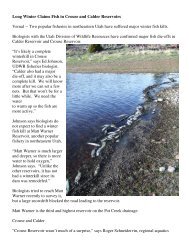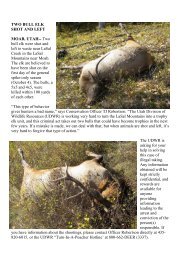Shirilla Wins Again; Three-time Shirilla Wins ... - Backcountry Utah
Shirilla Wins Again; Three-time Shirilla Wins ... - Backcountry Utah
Shirilla Wins Again; Three-time Shirilla Wins ... - Backcountry Utah
You also want an ePaper? Increase the reach of your titles
YUMPU automatically turns print PDFs into web optimized ePapers that Google loves.
plate for America's wildlife and natural resources decades before<br />
'environmentalism' became a popular movement."<br />
The federal excise tax on firearms and ammunition products (11 percent on long<br />
guns and ammunition and 10 percent on handguns), is collected by the U.S.<br />
Treasury, Tax and Trade Bureau (TTB) and given to the U.S. Fish and Wildlife<br />
Service (FWS) where it is deposited into the Wildlife Restoration Trust Fund,<br />
commonly referred to as the Pittman-Robertson Trust Fund. These taxes are the<br />
major source of conservation funding in the United States.<br />
"The federal excise taxes paid by manufacturers of firearms and ammunition<br />
through the Wildlife Restoration program provide state wildlife agencies this<br />
critical funding necessary to help maintain wildlife resources, educate hunters and<br />
fund sport shooting ranges nationwide," said Hall. "For example, my home state of<br />
Kentucky used these funds to restore elk populations to sustainable levels. Now,<br />
for the first <strong>time</strong> in hundreds of years, sportsmen and women have the opportunity<br />
to hunt elk east of the Mississippi River."<br />
In just the past 12 months, the firearms and ammunition industry has contributed<br />
more than $280 million to conservation via the Firearms and Ammunition Excise<br />
Tax (FAET). This amount of money demonstrates a 41 percent increase over the<br />
last five years. The complete amount collected through federal excise tax<br />
payments, a number which includes payments from the archery and fishing<br />
industries, tops $1 billion a year.<br />
"For over 70 years, state fish and wildlife agencies have used the revenue from the<br />
Pittman-Robertson program to build the most successful wildlife conservation<br />
model the world has ever known," said Hogan. "One needs only look at the return<br />
of species like the whitetail deer, wild turkey, pronghorn antelope and the wood<br />
duck, to name a few, to see that this money has been well spent for the benefit of<br />
all Americans."<br />
Industry Introduces Plan to Supplement NAWCA<br />
Demonstrating its continued support for conservation, industry announced a plan to<br />
supplement congressional funding (currently $75 million dollars) of the North<br />
American Wetland Conservation Act -- a grant program providing federal costshare<br />
funding to support the North American Waterfowl Management Plan. "NSSF<br />
is proud to announce a new multi-pronged three-year initiative to support wetlands<br />
conservation," commented Lawrence G. Keane, NSSF senior vice president and<br />
general counsel.





